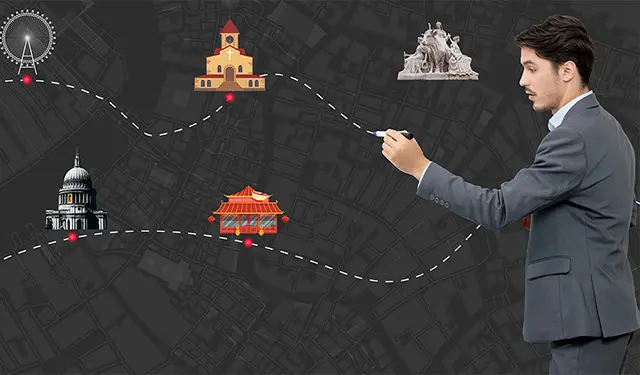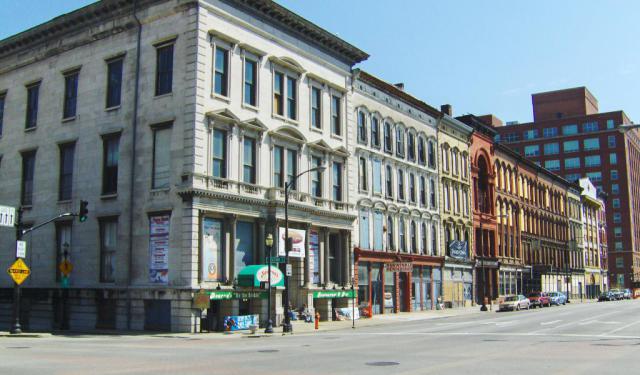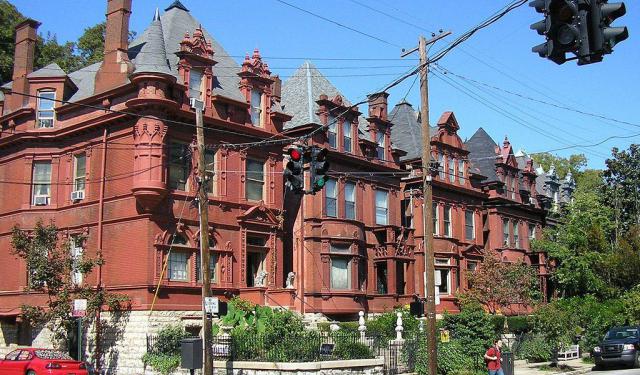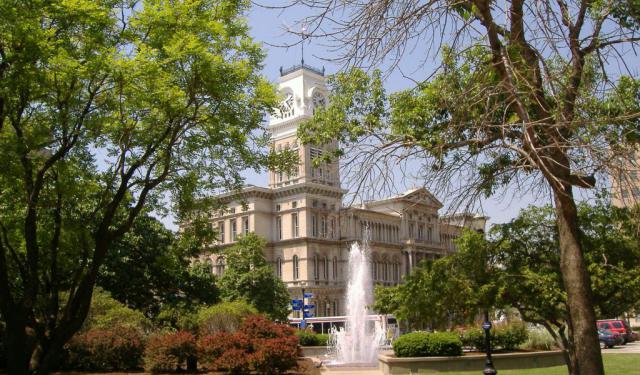Old Bank of Louisville, Louisville
The Old Bank of Louisville, also known as the Southern National Bank Building, stands on West Main Street in downtown Louisville. Completed in 1837 and designated a National Historic Landmark in 1971, it is widely regarded as one of the finest examples of small-scale Greek Revival architecture in the United States. Originally built to house the Bank of Louisville-chartered in 1833-the building is now incorporated into the Actors Theatre of Louisville, serving as its entrance and grand lobby space.
The building’s narrow but commanding limestone façade features two fluted Ionic columns set between bold, battered piers in a distyle in antis arrangement-an ancient architectural form rarely seen in American commercial structures. Cast-iron palmette motifs crown the entablature, replacing the conventional pediment with a richly detailed parapet. Though long attributed to Gideon Shryock, who oversaw construction, the design is now firmly credited to James H. Dakin, a young New York architect whose inventive approach combined Grecian ideals with bold reinterpretations, possibly influenced by both Egyptian gateways and contemporary pattern books like The Beauties of Modern Architecture.
Inside, the main banking hall is an equally ambitious space. Ionic columns and pilasters frame a rectangular plan, crowned by an elliptical dome supported on a curving frieze-a creative break from classical norms. The central oculus, originally filled with a sky-painted skylight, evokes the Roman Pantheon and brings natural light into the dramatic interior. Behind the hall, the original layout included vaults, offices, and a rear stairwell. In 1972, architect Harry Weese transformed the structure into part of the Actors Theatre complex, seamlessly blending Dakin’s historic vision with modern performance spaces. Today, the Old Bank remains a striking architectural landmark and a vivid reminder of Louisville’s 19th-century civic ambition.
The building’s narrow but commanding limestone façade features two fluted Ionic columns set between bold, battered piers in a distyle in antis arrangement-an ancient architectural form rarely seen in American commercial structures. Cast-iron palmette motifs crown the entablature, replacing the conventional pediment with a richly detailed parapet. Though long attributed to Gideon Shryock, who oversaw construction, the design is now firmly credited to James H. Dakin, a young New York architect whose inventive approach combined Grecian ideals with bold reinterpretations, possibly influenced by both Egyptian gateways and contemporary pattern books like The Beauties of Modern Architecture.
Inside, the main banking hall is an equally ambitious space. Ionic columns and pilasters frame a rectangular plan, crowned by an elliptical dome supported on a curving frieze-a creative break from classical norms. The central oculus, originally filled with a sky-painted skylight, evokes the Roman Pantheon and brings natural light into the dramatic interior. Behind the hall, the original layout included vaults, offices, and a rear stairwell. In 1972, architect Harry Weese transformed the structure into part of the Actors Theatre complex, seamlessly blending Dakin’s historic vision with modern performance spaces. Today, the Old Bank remains a striking architectural landmark and a vivid reminder of Louisville’s 19th-century civic ambition.
Want to visit this sight? Check out these Self-Guided Walking Tours in Louisville. Alternatively, you can download the mobile app "GPSmyCity: Walks in 1K+ Cities" from Apple App Store or Google Play Store. The app turns your mobile device to a personal tour guide and it works offline, so no data plan is needed when traveling abroad.
Old Bank of Louisville on Map
Sight Name: Old Bank of Louisville
Sight Location: Louisville, USA (See walking tours in Louisville)
Sight Type: Attraction/Landmark
Guide(s) Containing This Sight:
Sight Location: Louisville, USA (See walking tours in Louisville)
Sight Type: Attraction/Landmark
Guide(s) Containing This Sight:
Walking Tours in Louisville, Kentucky
Create Your Own Walk in Louisville
Creating your own self-guided walk in Louisville is easy and fun. Choose the city attractions that you want to see and a walk route map will be created just for you. You can even set your hotel as the start point of the walk.
Louisville Architecture Walking Tour
Louisville, Kentucky, is famous for its architectural marvels, featuring a combination of styles and eras, sizes and artistic directions, adding a great deal of uniqueness to the city panorama. Architecture buffs will be delighted at a chance to admire the elaborate edifices abounding the city.
One such iconic spot is Whiskey Row. Once a bustling hub of the local bourbon industry, it has been... view more
Tour Duration: 2 Hour(s)
Travel Distance: 2.8 Km or 1.7 Miles
One such iconic spot is Whiskey Row. Once a bustling hub of the local bourbon industry, it has been... view more
Tour Duration: 2 Hour(s)
Travel Distance: 2.8 Km or 1.7 Miles
Historical Old Louisville Walking Tour
The third largest urban district in the United States and the country's largest preservation district of Victorian-era buildings, the Old Town of Louisville is an ideal area in which to travel through the city's history. It is here that Louisville's oldest and most peculiar houses and other reminders of the past are concentrated, featuring a wealth of architectural styles.
... view more
Tour Duration: 1 Hour(s)
Travel Distance: 2.2 Km or 1.4 Miles
... view more
Tour Duration: 1 Hour(s)
Travel Distance: 2.2 Km or 1.4 Miles
Louisville Introduction Walking Tour
Poised on the banks of the Ohio River, Kentucky's largest city Louisville blends small-town charm with urban sophistication. The first European settlement in the vicinity of modern-day Louisville was on Corn Island, established in 1778 by Col. George Rogers Clark, credited as the founder of the city. Two years later, the Virginia General Assembly approved the town charter of Louisville. The... view more
Tour Duration: 2 Hour(s)
Travel Distance: 4.5 Km or 2.8 Miles
Tour Duration: 2 Hour(s)
Travel Distance: 4.5 Km or 2.8 Miles






